Think back to October 24th, 2005, when Hurricane Wilma blew into South Florida. It wasn't the strongest storm we've ever had, but it turned the lights out for a record number of people: 3.2 million FPL customers were in the dark, left without power, many for more than a week.
In Wilma's aftermath, the utility company started a major effort to beef up the whole electrical grid. Crews installed new, heavy-duty poles for main transmission lines, and they hardened feeder lines, too, with a strategy to concentrate on critical facilities, like hospitals.
"These lines now that feed hospitals such as this one behind me can withstand wind gusts up to 149 miles per hour," said FPL spokesman Mayco Villefana, standing in front of Aventura Medical Center.
The idea is if they don't have to worry about hospitals, fire, and police stations, the power company can concentrate on fixing outages in residential neighborhoods after a hurricane. Part of that involves burying power lines whenever possible.
"We think underground is the way to go in many occasions," Villefana says. "For example, the lines that feed directly into the vault of this hospital are underground."
Villefana told us FPL has increased the number of underground transmission lines since 2005, up to about 40 percent of its total installations, and not just to hospitals. Gas stations and supermarkets are also considered critical needs, so FPL has been giving them priority in strengthening feeder lines. Remember after Wilma, living through the nightmare of trying to gas up your car when hardly any gas stations had electricity?
"People want to get back out there quickly, get their lives back in order, and we learned that lesson," Villefana said.
Local
Since 2006, FPL has spent about $100 million a year on improvements. In South Florida, that means strengthening 121 main power lines, doing infrared inspections of 1,200 critical lines, and crews have inspected 159,000 poles, which is 66 percent of the total number of power poles in Miami-Dade and Broward Counties. They've also trimmed trees along 14,000 miles of power lines.
"It's not done yet, we continue to look at the critical infrastructure and see what else needs to be done," Villefana told us.
So they can't promise no downed power lines, no outages after a hurricane, but Florida Power and Light can promise the grid is in much better shape now than it was in October of 2005.



